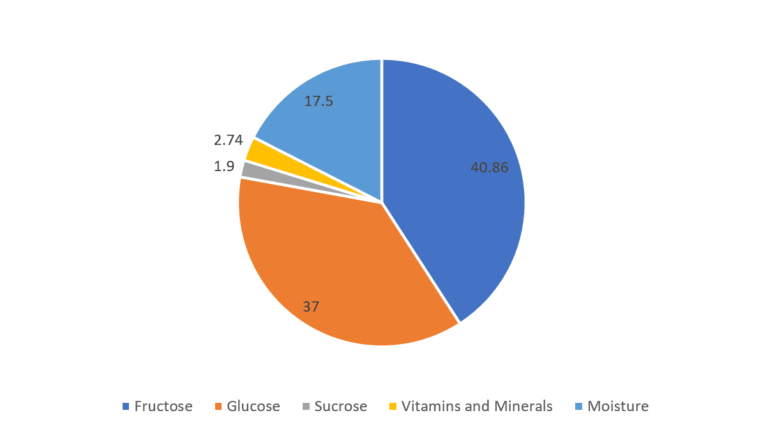

Testing Honey
Composition of Natural Honey


Fructose: Fructose is a kind of sugar and the sweetest form of sugar found naturally in honey. Its occurrence varies from 21% to 42% in natural honey. It is also called ‘fruit sugar or levulose’ because it is derived from plants. Honey contains fructose because honey is also made by the honeybees from nectar.
Permissible values by fssai: 21 % to 42 %
Glucose: Glucose is also found in honey naturally. This is derived when the honeybees break down sucrose by using their enzymes. It also accounts for crystallization (or looks like Deshi Ghee at bottom) of honey over a period of time which is commonly understood as deposition of sugar in market. Which is a myth. Read more here
Permissible values by fssai: 20 % to 40 %
Sucrose: Sucrose is the third last major sweetening substance found naturally in honey. Most of the sucrose is already broken down by the bees in fructose and glucose. But it is still different from common sugar.
Permissible values by fssai: maximum 5 %
Moisture: Moisture as we know very well is water content in honey. It comes from the nectar and environment with the honeybees. It gives honey its liquid state thus necessary component in honey.
Permissible values by fssai: 17% to 20 %
f/g ratio: It is simply the ratio of glucose to fructose in honey.
Permissible values by fssai: 0.95 % to 1.5 %
Specific gravity: Specific gravity of honey means the ratio between density of honey and density of water. It typically ranges between 1.38 and 1.42
Permissible values by fssai: Minimum 1.35
Acidity: Honey has some organic acids (majorly gluconic acid) which are produced naturally by the honeybees. It is produced by the breakdown of glucose by bees through their enzymes. This acid is significant because it gives honey its taste and aroma.
Permissible values by fssai: Maximum 0.2 % w/w
HMF (Hydroxy Methyl Furfuraldehyde): It indicates the heat and storage conditions of honey. HMF is produced by breakdown of fructose by an acid. And heat increases this reaction of breakdown.
Permissible values by fssai: Maximum 80 mg/kg
Fiehe’s Test: It is test to find adulteration of honey with any sugar. For a pure honey it should always be negative.
Water insoluble matter: It accounts for pollen and other substances in honey.
Permissible values: Maximum 0.3 %
As per FSSAI norms, honey should pass all the above parameters to be sold. At Aravali Honey Industries we provide test report with honey also which comply with all these parameters (any specific test is also provided if requested).
No, the Glycemic Index (GI) of sugar is greater than honey. This means sugar raises our blood sugar level more quickly than natural honey. Also the fructose and glucose are easily digested than sucrose (very high in sugar as compared to honey) contents in honey are digested easily. Thanks to our honeybees who do this already while making honey.
Yes, we provide test reports with honey (as provided here and specific tests are also provided on request.
For quality maintenance we follow scientific beekeeping at every step from bee farm level to filtration and packaging. click here to know more
As stated above honey is always a better alternative than sugar. And if we focus on some facts and analysis then Jamun honey is recommended the most for diabetic people.
Honey is sweet because of presence of Fructose, Glucose and Sucrose. These are major components of natural honey which are sweet in nature. Read more about natural honey.